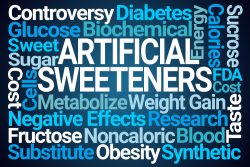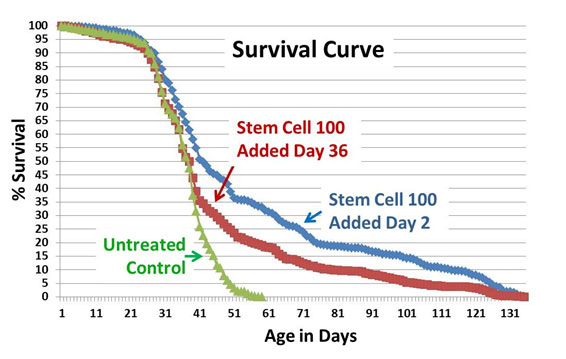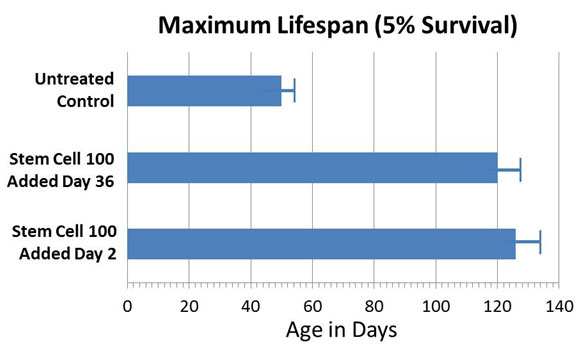Autophagy keeps the molecules in your cells in good working order. Cells make a lot of defective molecules. They misread genes, for example, and misfold proteins. Even a perfectly crafted molecule does not stay perfect for long. ?Proteins go bad with time,? said Daniel Klionsky of the University of Michigan. ?They age, and they wear out.?
In fact, as Dr. Klionsky wrote in a paper published online in Trends in Cell Biology, this cannibalism may extend our lifespan. Increasing our body?s ability to self-destruct may, paradoxically, let us live longer. ?All of a sudden, researchers in different fields are seeing a connection.?
When proteins and other molecules go bad, they can start to gum up the intricate chemical reactions on which a cell?s survival depends. The cell recognizes defective parts and tags them for destruction. Experiments on flies show the harm that can occur when cells cannot clear away the old and bring in the new. Flies that are genetically engineered with defective lysosomes start to accumulate abnormal clumps of proteins in their cells. The clumps build up especially in their neurons, which start to die as a result.
As mitochondria get old, they cast off charged molecules that can wreak havoc in a cell and lead to mutations. By gobbling up defective mitochondria, lysosomes may make cells less likely to damage their DNA.
Unfortunately, as we get older, our cells lose their cannibalistic prowess. The decline of autophagy may be an important factor in aging. Unable to clear away the cellular garbage, our bodies start to fail.
If this hypothesis turns out to be right, then it may be possible to slow the aging process by raising autophagy. It has long been known, for example, that animals that are put on a strict low-calorie diet can live much longer than animals that eat all they can. Recent research has shown that caloric restriction raises autophagy in animals and keeps it high. The animals seem to be responding to their low-calorie diet by feeding on their own cells, as they do during famines. In the process, their cells may also be clearing away more defective molecules, so that the animals age more slowly.
Our cells build two kinds of recycling factories. One kind, known as the proteasome, is a tiny cluster of proteins. It slurps up individual proteins like a child sucking a piece of spaghetti. Once inside the proteasome, the protein is chopped up into its building blocks.
For bigger demolition jobs, our cells rely on a bigger factory: a giant bubble packed with toxic enzymes, known as a lysosome. The Belgian biochemist Christian de Duve discovered lysosomes in 1955, for which he later won the Nobel Prize. Lysosomes can destroy big structures, like mitochondria, the sausage-shaped sacs in cells that generate fuel. To devour a mitochondrion, a cell first swaddles it in a shroudlike membrane, which is then transported to a lysosome. The shroud merges seamlessly into the lysosome, which then rips the mitochondrion apart. Its remains are spit back out through channels on the lysosome?s surface.
Lysosomes are versatile garbage disposals. In addition to taking in shrouded material, they can also pull in individual proteins through special portals on their surface. Lysosomes can even extend a mouthlike projection from their membrane and chew off pieces of a cell.
The shredded debris that streams out of the lysosomes is not useless waste. A cell uses the material to build new molecules, gradually recreating itself from old parts. ?Every three days, you basically have a new heart,? said Dr. Ana Maria Cuervo, a molecular biologist at Albert Einstein College of Medicine.
This self-destruction may seem like a reckless waste of time and energy. Yet it is essential for our survival, and in many different ways. Proteasomes destroy certain proteins quickly, allowing them to survive for only about half an hour. That speed allows cells to keep tight control over the concentrations of the proteins. By tweaking the rate of destruction, it can swiftly raise or lower the number of any kind of protein.
Lysosomes, which eat more slowly than proteasomes, serve different roles that are no less essential. They allow cells to continue to build new molecules even when they are not getting a steady supply of raw ingredients from the food we eat. Lysosomes also devour oily droplets and stores of starch, releasing energy that cells can use to power the construction of new molecules.
?If you don?t have a snack between lunch and dinner,? Dr. Cuervo said, ?you?re going to have to activate your lysosomes to get nutrients.?
Lysosomes become even more active if dinner never comes, and a short-term hunger turns to long-term starvation. Cells respond to famine by making only a small number of crucial molecules and using lysosomes to destroy the rest. ?When times are good, make everything,? Dr. Klionsky said. ?When times are lean, focus on what you need. You can get rid of everything else.?
This strategy for survival, known as autophagy (?eating oneself?), evolved in our ancestors over two billion years ago. Today, all animals rely on it to endure famines, as do plants, fungi and single-cell protozoa.
Autophagy?s great antiquity has helped scientists discover the genes that make it possible in humans. Rather than study starving people, they introduced mutations into yeast and then observed which strains could no longer survive without food. In many cases, the scientists discovered, the mutations that made yeast vulnerable struck genes that are involved in autophagy. They were then able to find nearly identical versions of those genes in the human genome.
The protection humans get from lysosomes is essential not just during famines. It is also vital just after birth. When babies emerge from their mothers, they need huge amounts of energy so that they can start to run their bodies on their own. But this demand comes at precisely the moment that babies stop getting food through their umbilical cord. Japanese scientists have found that lysosomes in mice kick into high gear as soon as they are born. After a day or two, as they start to nurse, the rate of autophagy drops back to normal.
When the scientists engineered mice so they could not use their lysosomes at birth, the newborn mice almost immediately died of starvation.
Some scientists are investigating how to manipulate autophagy directly. Dr. Cuervo and her colleagues, for example, have observed that in the livers of old mice, lysosomes produce fewer portals on their surface for taking in defective proteins. So they engineeredmice to produce lysosomes with more portals. They found that the altered lysosomes of the old experimental mice could clear away more defective proteins. This change allowed the livers to work better.
?These mice were like 80-year-old people, but their livers were functioning as if they were 20,? Dr. Cuervo said. ?We were very happy about that.?
Andrea Ballabio, the scientific director of Telethon Institute of Genetics and Medicine in Naples, Italy, and his colleagues have found another way to raise autophagy. By studying the activity of genes that build lysosomes, they discovered that at least 68 of the genes are switched on by a single master protein, known as TFEB.
When Dr. Ballabio and his colleagues engineered cells to make extra TFEB, the cells made more lysosomes. And each of those lysosomes became more efficient.









